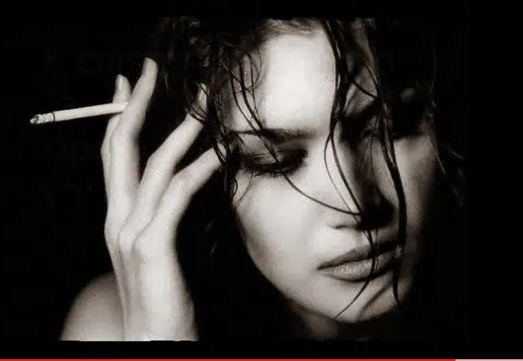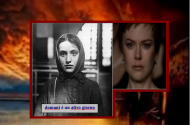Scapigliatura:
“During the 1860s [through the 1880s] a group of literary artists (some of them also painters and composers) active mostly in Milan came to be known as ‘scapigliatura’. They where radically opposed to bourgeois manners, habits, and aesthetic ideals” (Dictionary of Italian Literature emp. +).
“...an artistic movement [consisting of ] painters, composers, and writers who rejected bourgeois values in morality and art” (translator’s “Introduction” to Passion i.e. translation of Fosca emp.+)
Call me a cynic if you will, but... Living a self-indulgent bohemian urban life style and struggling with the profound issues of adolescent-esque love affairs (immortalized in Puccini’s La Bohème), scapigliati artist were opposing bourgeois moral values while sipping cappuccino in Milan’s cafes. Meanwhile, south of Rome Terroni brigadista were fighting to the death the immoral bourgeoisie invading armies of the Piedmont.
For example, the renowned scapigliatista Iginio Ugo Tarchitte wrote the unrequited love novel Fosca, printed in serials for the Milan literary magazine “Pungolo”, to the delight of Milanese literati. How nice! How sweet! Writing and reading love stories in the spirit of rejecting bourgeois morality, while the hundred and ten thousand man strong bourgeoisie Piedmontese army was ravaging the people of Two Sicilies. In contemporary idiom – “Go Figure!”
Nevertheless, apart from the absurd moral claims of these nineteenth century northern Italian ‘Hippies’, from the point of view of social history, their work is a window into the values of their times and provides a basis for studying the evolution of those values down to the literature of present day Italian Americana. Much can be learned about the history and culture of Italian Americana from a comparative analysis of novels like Fosca and those of today’s Lisa Scottoline.
Fosca
The main plot of the novel is the story of the relation between Giorgio a young Italian Army officer and Fosca the cousin of Giorgio’s superior officer. The sub-plot has to do with the relationship between Giorgio and a married women Clara. For purposes of this discussion, the most significant aspect of the novel is the hysterical (literally) characteristics of Fosca.
The character Fosca that Tarchetti introduced is far different than the hysterical Fosca he developed in his plot. Fosca is introduced as more of a twenty-first century women than nineteenth. She is intelligent, well educated, widely read, analytical and witty. We are told:
“[Fosca] devours books, she is a bookworm, she reads the way [men] smoke... [Giorgio] lent her Rousseau’s la nouvella Heloise, La Fortaine’s L’Homme Singulier and les Confessions a las Tombe...[She] returned them with paper notes and marked passages [that revealed] an intelligence that was robust, subtle, perspicacious. That woman was gifted... (Passion p. 40 emp.+)
“She was tall and stood erect...displayed pliancy, grace, was courteous and dressed with a great deal of elegance.” (p. 42)
“Her spirit was not superficial; her intelligence was much more profound than a woman’s intellect ordinarily is; she was clever, and possessed a refinement of manners that was quite singular.” (p. 47 emp.+)
Such were the introductory descriptions that Tarchetti gives us to this extraordinary woman. He then goes on to put words in her mouth to complement and reinforce the description. In a philosophical discussion about “death”, Giorgio asks rhetorically:
“Does not the mere sensation of existing, seeing, hearing, touching, moving, breathing in this place make life attractive to you?”
Fosca’s response would have delighted Shakespeare:
Why didn’t you add ‘thinking’...You don’t know the abysses of thought...nor its tortures...It is one thing to imagine, to delude yourself, and quite another to experience and be conscious of a true blessing...who would prefer the possession of the smallest blessing to the image of an immeasurable one?” (p50-53 emp.+)
Thus, in chapter seventeen of a fifty-chapter book we are introduced to this gracious and intelligent woman. However, this representation proves to be ephemeral. For the rest of the novel Tarchetti reverts Fosca to her times, a wily manipulative woman who uses her ‘looks’ and ‘illness’ to manipulate her man. Not unlike Cleopatra, also an intelligent woman who used her beauty to entice and control, Fosca uses her ugliness to the same end. Tarchetti transformers her into a manipulative antagonists who destroys her devoted cousin, herself and Giorgio.
Fosca suffers from hysteria. Hysteria throughout the nineteenth century and into the twentieth with the writings of Freud denoted in medical parlance a psychopathology peculiar to women and associated with sexuality e.g. repression. Along with and due to the hysterical conditions, Fosca suffered various physical illnesses. The sum total of her conditions resulted in a woman who was extreme ‘ugly’ and skinny. In short, not only was she unattractive, but more accurately repulsive.
Her physical condition in turn gave rise to loneliness and wanting for love. From the time of her introduction to Giorgio, she used her condition to manipulate his kindness and his own psychological issues to her selfish ends; resulting in the tragic ending of the novel. In the nineteenth century a woman had no place to apply their intelligence. And, if they were unattractive they were if not literally then de facto cloistered.
One hundred and fifty years later, intelligent Italian American women are still struggling to actualize themselves in a society that is both male dominated and often at odds with the Italian American value system. Lisa Scottoline explores these issues in the context of legal and moral conflicts of her Italian American female “gumshoe” lawyers.
“Great” literature and Scottoline’s melodramas
Lisa Scottoline’s Novels
|
Titles
|
Published
|
|
Everywhere That Mary Went
|
1993
|
|
Final Appeal
|
1994
|
|
Running From the Law
|
1996
|
|
Legal Tender
|
1996
|
|
Rough Justice
|
1997
|
|
Mistaken Identity
|
1999
|
|
Moment of Truth
|
2000
|
|
The Vendetta Defense
|
2001
|
|
Counting Trouble
|
2002
|
|
Dead Ringer
|
2003
|
|
Killer Smile
|
2004
|
|
Devil's Corner
|
2005
|
|
Dirty Blonde
|
2006
|
|
Daddy's Girl
|
2007
|
|
Lady Killer
|
2008
|
|
Look Again
|
2009
|
|
Think Twice
|
2010
|
|
Save Me
|
2011
|
To my mind (i.e. subjective aesthetic judgment), Lisa Scottoline has in her a (perhaps the) great post-Little Italy Italian American novel. She has a thorough grasp of the people, history, culture and issues of contemporary Italian Americana and she is an excellent writer. However, I don’t think she will write such a book. Indeed, I don’t think she is capable. She lacks what Miguel de Unamuno called the “tragic sense of life” or the “existential dread” of Sartre and Camus. In short, what is generally thought to be “great literature” is ‘heavy’.
Unlike DeLillo who, while brushing up to but falling short of a great post Little Italy novel with “Underworld”, destroyed Bronzini and emasculated Nick; Scottoline loves her Italian American characters and Italianita too much to inflict Orestia-esque suffering and destruction on them. In short, she can’t sing the “goat’s song.”
She is only capable of ‘Yea saying’ when it comes to Italians. Which is not to say she is unaware or does not explore their shortcomings. However, those shortcomings are cast as Italian manifestations of ‘human frailty’ generally. And, she has the self-confidence in her heritage to cast those shortcomings comically. In contradistinction of the contemporary hypersensitive defensive ethnic milieu, she allows Italian Americans to laugh at themselves. She has too much sense of humor to write tragedy. Her wit pours out of her characters' mouths even in the most incongruous unhumorous scenes.
Further, she is a great melodramatic writer; she loves to tell a good story and twist a plot beyond the reader’s anticipation. Deus ex machina, thought to be a shortcoming of literary plots, is her forte. She is uncanny in contriving situations that drive the plot's rising and falling actions. Just when the protagonist seems to have escaped a situation, or the plot seems to be at a dead-end, the machina ‘kicks-in’ and “it’s off and running again.”
{Parenthetical note: There are those who argue that a definitive characteristics of ‘excellent’ literature, as opposed to lesser melodramatic writing, is a plot where action is rigorously governed by cause and effect – i.e. every action in the plot is ‘caused’ by an antecedent action – see for example, Elder Olsen of the “Chicago Critics” and Lajos Egri in his book “The Art of Dramatic Writing”.
However, it should be pointed out that the plot of a literary masterpiece such as “Crime and Punishment” is repeatedly moved by characters who (ex machina) ‘just happen’ to meet on the streets of a city the size of St. Petersburg. And, the not so highly regarded (in literary circles) novel “The Godfather” has, I would argue, an absolutely perfect ‘cause and effect’ plot.
In short, plot is a not the characteristic of excellent literature. The “tragic senses of life” is probably a better measure of great literature and differentiator of melodrama}
Scottoline’s Women
University “Chairs of Wisdom” would not place Scottoline on student’s ‘must read” literature list – if on the list at all. Her fun to read “Nancy Drew” like detective stories are not the type of reading for which one gets college credit (the motto of college literature: “No Pain – No Gain”). However, when placed in the context of Italian and Italian American social history, Scottoline’s books are significant and, I would say, must reading! I would especially highly recommend them for southern-Italian American adolescent reading as a window to their history and culture; especially the excellent historic novel Killer Smile, that explores the internment of Italian Americans during the Second World War.
The single most prominent aspect of contemporary American Italianita in her books are her female Italian American characters. The plots of her fictional works are mostly built around the lives of Italian American female lawyers (amateur detectives) working in the all female law firm of Rosato & Associates. It is though the eyes of these Italian American women that the reader ‘sees’ the history and fossilized remnants of “Little Italy” (south Philadelphia). Through them we see the post Little Italy world in which the Italian American woman lives, works and struggles to reconcile her peasant origins and values with the contemporary urban world. And, with them the reader is invited to Socratically probe the often contradictory and nebulous concepts of ‘justice’ vs. ‘legal’, and evil (nature vs. nurture).
Conclusion
Scottoline’s Italian women are at once the same and radically different than Tarchetti’s Fosca. Like Fosca they are the product of the same Italian cultural roots affecting a women in a “man’s world” where female intelligence is not respected; and at the same time they are a giant evolutionary step away from Fosac in that they continually render male dominance moot. Scottoline's women do succeed, albeit with super effort.
Looking at the ape we see the human and looking at the human we see the ape. Similarly, we see Fosca in Scottoline’s women and vise versa.
American students of southern-Italian descent should be able to study the literature of post-Risorgimento Italy and contemporary Italian American writers in the context of a unified evolving Italian culture. Tell that to the "Chairs of Wisdom"!








Is this sultry beauty in the
Is this sultry beauty in the photo really Lisa Scottoline? I have visited this writer's Webpage and, frankly, the photos there show somebody surely attractive, but I don't think it's the same person...